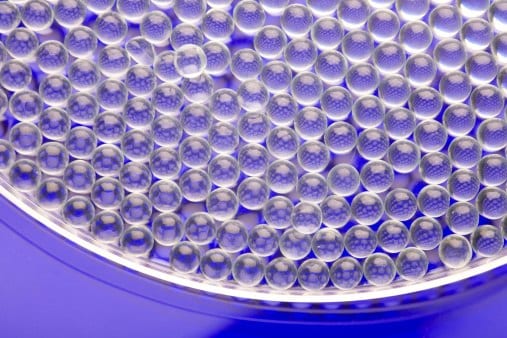Self-Assembly & Contact Printing

Molecular Self-Assembly
Molecular self-assembly (MSA) is the assembly of molecules without guidance or management from an outside source. Self-assembly can occur spontaneously in nature. One such example is the self-assembly of the lipid bilayer membrane in cells. The accurate and controlled application of intermolecular forces can lead to new and previously unachievable nanostructures.
In self-assembly, the final (desired) structure is ‘encoded’ in the shape and properties of the molecules that are used. Self-assembled monolayers (SAMs) use relatively weak intermolecular interactions between certain types of organic molecules as the driving assembly force, including the electrostatic interaction between oppositely charged polyelectrolytes, the affinity between thiols and gold surfaces or between phosphonic acids and oxidic surfaces.
Products
Thiols and Gold Surfaces
Several forces drive the assembly of alkyl thiols on a gold surface. In addition to the strong sulfur-gold interactions (~45 kcal/mol) allowing relatively strong bonding of the film-forming molecules to the surface, the hydrophobic interactions between carbon and hydrogen atoms in the alkyl thiol molecules also significantly lower the overall surface energy especially when the alkyl chain contains at least ten carbon atoms.
We offer various high purity thiol materials for a wide variety of self-assembly applications from soft lithography to chemical and biological detection, categorized by the type of thiol groups:
- Alkyl thiols (-CH3 terminated)
- Functionalized thiols
- Dithiols
- Ring thiols
- Protected thiols
Phosphonic Acids and Oxide Surfaces
We offer a selection of phosphate and phosphonate materials to expand the choice of the substrate used for the preparation of self-assembled monolayers beyond gold. Our polar acidic molecules interact with diverse metal-oxide surfaces (e.g., Al2O3, Ta2O5, NbO5, ZrO2 and TiO2) and form films with a similar degree of ordering as for alkyl thiol SAMs on gold.
Nanoimprint Lithography
Nanoimprint lithography (NIL) is a technique to generate micro- and nanostructures in hard polymers by pressing a rigid master containing surface-relief feature into a thin thermoplastic polymer film that is then heated close to or, more generally, above Tg. It has the potential to produce nanodevices in a high-throughput manner, does not require sophisticated tools, and allows nanoscale replication for data storage.
We offer a range of nanoimprinting materials, e.g. poly(methyl methacrylate) (PMMA), and other thermoplastic and thermosetting polymers (such as Polydimethylsiloxane PDMS and polyphthalaldehyde) to optimize the imprinting and subsequent etching steps.
Soft Lithography
Soft lithography uses micromolding and embossing of ‘soft’ elastomers to fabricate or replicate structures. In microcontact printing (mCP), a monolayer of a material is printed off an elastomeric stamp made of poly(dimethylsiloxane) (PDMS) after forming conformal contact between stamp and substrate. Sub-micron surface relief structures can easily be introduced in PDMS by curing the polymers against a lithographically prepared master. The advantage of mCP is the ability to pattern surfaces chemically at the sub-micron level. An elastomeric stamp is inked with small molecules (thiols or silanes) and pressed against a clean substrate (gold or silicon wafer). Where the stamp is in contact with the surface, a monolayer of material is transferred to the substrate. A second thiol or silane is then used to fill in the background to provide a chemically patterned surface.
We offer a comprehensive selection of silane, thiol and PDMS materials to empower your applications requiring precise micropatterning and nanopatterning.
Related Resources
- Article: Self-Assembled Nanodielectrics (SANDs) for Unconventional Electronics
Review the potential of self-assembled multilayer gate dielectric films fabricated from silane precursors for organic, inorganic, and transparent TFT and for TFT circuitry and OLED displays.
- Article: Molecular Self-Assembly on Gold Using Thioacetates
- Article: Deposition Grade Silanes for Sol-Gel Processes
Deposition Grade Silanes, fully characterized by chemical analysis and nuclear magnetic resonance (NMR) with greater than 98% purity, for Sol-Gel Processes.
- Article: Introduction to Molecular Self-Assembly
Molecular self-assembly, explored through electrostatic and monolayer approaches, is significant in material science.
- Article: Preparing Self-Assembled Monolayers
SAMs are versatile surface coatings for chemical resistance, bio-compatibility, sensitization, and molecular recognition for sensors and nano fabrication.
- Article: Lithography Nanopatterning Tutorial
Sigma-Aldrich tutorial on lithography nanopatterning explains patterning layers for conductors, semiconductors, and dielectrics on surfaces.
- Article: Carborane Thiols: A New Family of Self-Assembly Materials
To continue reading please sign in or create an account.
Don't Have An Account?